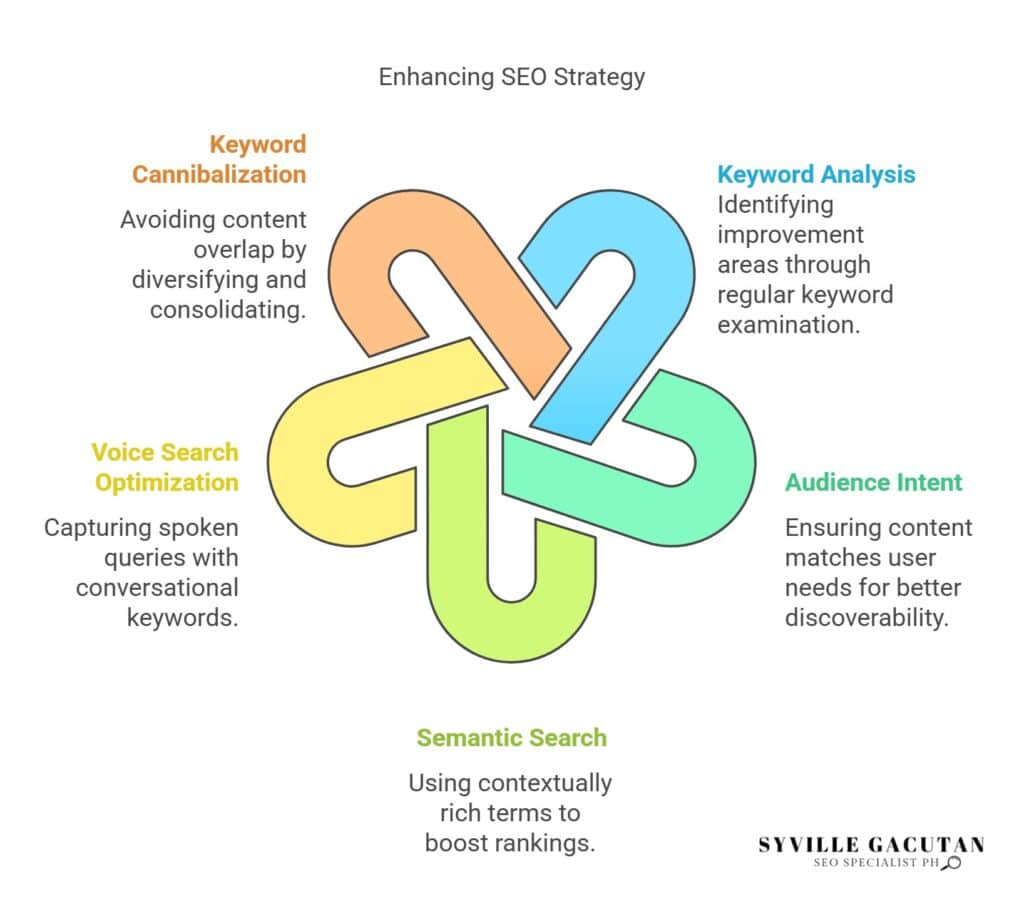
Is Your Keyword Strategy Missing This Crucial Element?
Your keyword strategy may be lacking an important aspect: identifying and taking advantage of keyword gaps. This means comparing your keywords with those of your competitors to find opportunities you’ve missed, which can significantly improve your search engine performance & visibility. Understanding audience intent, optimizing for voice search, and considering semantic search impacts are also essential facets of a robust keyword strategy. Additionally, ensuring content relevance, balancing search volume with competition, and avoiding keyword cannibalization can greatly improve your results. A mobile-first indexing approach is also crucial in today’s digital landscape. Explore to uncover the techniques in improving website visibility through keyword research.
Key Takeaways
- Regularly analyzing the keywords on a website helps identify improvement areas and enhances visibility on search engines, allowing businesses to align their content with popular search terms through keyword gap analysis, ultimately increasing their chances of attracting potential customers.
- Understanding audience intent ensures content matches user needs and enhances discoverability.
- Adapting to semantic search by using contextually rich terms boosts rankings and engagement.
- Optimizing for voice search with long-tail, conversational keywords captures spoken queries effectively.
- Avoiding keyword cannibalization by diversifying and consolidating similar content enhances ranking potential.

Understanding Keyword Gaps
Finding keyword gaps is an important part of optimizing your website’s search engine performance. By pinpointing these gaps, you can uncover opportunities to enhance your site’s visibility and drive more organic traffic.
Keyword research for SEO is an essential practice that involves analyzing the terms and phrases your target audience uses, but one often overlooked aspect is understanding where your content falls short compared to competitors. This is where the concept of a keyword gap becomes vital.
A keyword gap analysis entails comparing the keywords your website ranks for with those of your competitors. Through this competitor analysis, you can identify relevant keywords that you may have missed or underutilized. By filling these gaps, you can improve your content strategy and capture valuable search traffic that would otherwise go to your competitors.
In addition to identifying new keywords, understanding keyword gaps helps align your content that aligns with search intent. Search intent is about understanding the motivation behind a user’s query, whether they’re looking for information, making a purchase, or seeking a specific service. Ensuring that your content matches the search intent of high-potential keywords can significantly improve your website’s rankings and user engagement.
Moreover, effective keyword research for SEO involves continually revisiting and updating your keyword strategy. The digital landscape is ever-evolving, and keeping pace with changes in search behavior and competitor tactics is imperative.
Regularly conducting keyword gap analyses allows you to stay ahead and maintain a competitive advantage.
Identifying Audience Intent

Grasping the intricacies of audience intent is vital for crafting content that resonates and ranks well in search engines. Understanding user intent means deciphering what users truly seek when they enter search queries. This understanding can guide the selection of relevant keywords that meet the needs and expectations of your audience, ultimately driving engagement and conversions.
To begin identifying user intent, it is essential to categorize search queries into three primary types: informational, navigational, and transactional. Informational queries seek knowledge, navigational queries aim to locate a specific website, and transactional queries indicate a readiness to purchase or commit. Recognizing these distinctions enables marketers to tailor their content to align with the specific intentions behind each query type.
Keyword research tools like Google Keyword Planner, Ahrefs and SEMrush can be very helpful in understanding what people are looking for. These tools can show you the specific words and phrases that people use when searching for information online. By analyzing this data, you can get a better idea of what people want to find and create content that meets their needs. These tools not only give you information on search volume and competition but also offer insights into the context in which targeted keywords are used. By studying how people search & what they look for marketers can figure out which words and phrases are most important to the people they want to reach. They can then use these words in their marketing efforts to better connect with their target audience.
Incorporating relevant keywords that reflect user intent ensures that content is both discoverable and valuable. For instance, if the intent behind a search query is informational, content should be rich in detail and provide comprehensive answers. Conversely, if the intent is transactional, the content should be geared towards facilitating a purchase or action.
Ultimately, the success of a keyword strategy hinges on a deep understanding of audience intent. By leveraging keyword research tools and focusing on targeted keywords, marketers can create content that not only attracts traffic but also fulfills the specific desires and requirements of their audience.
Semantic Search Impact

With the rise of semantic search, the landscape of keyword strategy has undergone a significant transformation. Traditional keyword research, which once relied heavily on exact match keywords, is now evolving to encompass the broader context of user queries.
Semantic search, driven by advancements in artificial intelligence and natural language processing, prioritizes the intent and meaning behind search queries rather than focusing solely on specific keywords.
The impact on search engine optimization (SEO) is substantial. To align with this shift, your keyword strategy must adapt by incorporating relevant keywords that are contextually rich and semantically related. This means moving beyond simple keyword lists to developing content that answers user intent comprehensively.
For instance, instead of optimizing solely for “best running shoes,” consider related terms and phrases like “top athletic footwear for marathons” or “best sneakers for long-distance running.”
Effective keyword research in the era of semantic search involves understanding the myriad ways users might phrase their queries to find similar information. It calls for a thorough understanding of user intent, ensuring that the content created not only matches but anticipates the questions users are likely to ask.
This approach not only improves search engine rankings but also enhances user engagement by delivering more relevant and valuable content.
Voice Search Optimization

As semantic search continues to reshape keyword strategy, another significant evolution in SEO is the rise of voice search optimization. This paradigm shift demands a more nuanced approach to effective keyword research, focusing on how users interact with search engines through spoken queries. The increasing adoption of voice-activated devices, such as smart speakers and virtual assistants, has made it essential for businesses to adjust their strategies to capture this growing segment of search traffic.
Voice search optimization requires a departure from traditional keywords, emphasizing the importance of long-tail keywords. These longer, more conversational phrases reflect how people naturally speak when using voice search. For instance, instead of typing “best Italian restaurant,” a user might ask, “What is the best Italian restaurant near me?” Including such long-tail keywords in your content can enhance your visibility on search engine results pages.
Moreover, effective keyword research for voice search involves understanding the user’s intent and context. This means integrating relevant keywords that closely match the natural language patterns and questions users are likely to pose. Tools like Google’s Keyword Planner can assist in identifying these conversational phrases, ensuring your content is tailored to meet the nuances of voice search queries.
The ultimate goal of voice search optimization is to enhance user experience by providing accurate and immediate answers. By aligning your keyword strategy with the dynamics of voice search, you can improve your website’s ranking on search engine results pages, thereby driving more targeted traffic to your site.
As the landscape of SEO continues to evolve, staying ahead with voice search optimization may well be the crucial element your keyword strategy needs.
Content Relevance

Content relevance has emerged as a pivotal component of modern SEO, directly influencing a website’s search engine ranking and user engagement. In an era where algorithms are increasingly sophisticated, the importance of aligning your keyword strategies with content relevance cannot be overstated. Effective SEO is not merely about selecting high-traffic keywords but ensuring those keywords are seamlessly integrated into relevant content that adds value to the user experience.
To achieve this, a thorough understanding of your audience’s needs and search intent is imperative. Content relevance ensures that the material you produce addresses the specific queries your audience is making, thereby enhancing keyword performance. When users find the information they are looking for, they are more likely to stay on your site longer, reducing bounce rates and signaling to search engines that your content is valuable.
Moreover, relevant content fosters trust and authority, which are crucial for both user engagement and search engine algorithms. By consistently delivering content that meets the needs of your audience, you establish your site as a reliable source of information. This reliability, in turn, positively impacts your keyword performance, as search engines will more likely rank your site higher for relevant queries.
Balancing content relevance with keyword strategies also involves regular content audits and updates. Old or outdated content should be refreshed to maintain its relevance, ensuring it continues to perform well in search engine rankings.
Search Volume vs. Competition

Navigating the intricate dynamics of search volume versus competition is a critical aspect of formulating an effective keyword strategy. Striking the right balance between these two factors can significantly influence the success of your organic traffic goals. High search volume keywords are often tempting because they promise greater visibility. However, they usually come with steep competition, making it challenging for your content to rank highly on search engine results pages (SERPs).
To effectively weigh search volume against competition, leveraging a sophisticated keyword research tool is indispensable. These tools offer insights into the monthly search volume of keywords and the level of competition you’ll face. For instance, a keyword with 50,000 monthly searches may seem ideal, but if large, authoritative websites dominate the top positions, your content might struggle to gain traction.
On the other hand, targeting low-competition keywords with moderate search volume can yield more immediate and tangible results. These keywords, often referred to as “long-tail keywords,” may attract fewer searches individually, but collectively, they can drive substantial organic traffic. This approach also allows emerging websites to build authority and gradually target more competitive terms.
Ultimately, the core of a robust keyword strategy lies in a nuanced understanding of the interplay between search volume and competition. By carefully analyzing these parameters, you can identify opportunities where your content can thrive.
Keyword Cannibalization
Keyword cannibalization is a critical issue that can undermine the effectiveness of your SEO efforts. When multiple pages on your website target the same keyword, they compete against each other, leading to diluted search engine ranking and reduced visibility on search engines. This internal competition can confuse search engines, making it difficult for them to determine which page to rank for the keyword, ultimately affecting your overall keyword strategy.
To address keyword cannibalization, it’s essential to conduct a thorough audit of your content strategies. Identify pages that are targeting the same keywords and evaluate their performance metrics.
| Issue | Solution |
| Multiple pages targeting the same keyword | Consolidate content into a single, comprehensive page |
| Confused search engine ranking | Optimize internal linking to guide search engines |
| Reduced visibility on search engines | Use unique keywords for different pages |
Once identified, consider consolidating similar content into a single, comprehensive page. This can help centralize the authority of your content and improve its chances of ranking higher. Additionally, optimizing internal linking structures can guide search engines to understand the importance of each page, further enhancing your visibility on search engines.
Another effective approach is to diversify your keyword strategy. Ensure that each page targets unique keywords, thereby reducing the risk of keyword cannibalization. This practice not only clarifies your content strategies but also broadens your search engine ranking potential across a wider array of terms.
Mobile-First Indexing

Addressing keyword cannibalization is just one aspect of a robust SEO strategy; another critical component is adapting to the evolving landscape of search engine algorithms, particularly with the advent of mobile-first indexing.
Mobile-first indexing, introduced by Google, signifies that the mobile version of your website becomes the starting point for what search engines include in their index and the baseline for determining rankings. This shift underscores the necessity of ensuring that your keyword strategy is optimized for mobile users.
The transition to mobile-first indexing demands a reevaluation of your overall SEO strategy. Given that a significant proportion of users now access content via mobile devices, it is imperative that your website is mobile-friendly. This includes responsive design, fast loading times, and mobile-optimized content.
Search engines prioritize these factors when ranking sites, making it essential to align your keyword strategy accordingly.
Keyword research tools are invaluable in this context, offering insights into mobile-specific search trends and user behavior. Tools like Google Keyword Planner or SEMrush can help you identify keywords that perform well on mobile searches, ensuring that your content is tailored to meet the needs of mobile users.
Incorporating mobile-specific keywords into your content strategy not only enhances user experience but also improves your site’s visibility on search engines.
Remember, a mobile-first approach is not just about technical adjustments; it encompasses a holistic keyword strategy that aligns with the mobile-centric habits of today’s users.
Final Thoughts
An effective keyword strategy is crucial for enhancing your website’s visibility and driving organic traffic. By identifying keyword gaps, understanding audience intent, and adapting to semantic and voice search, you can optimize your content to meet user needs more accurately. The integration of LSI keywords, along with the careful analysis of search volume versus competition, allows for a more robust approach to SEO. Additionally, addressing keyword cannibalization and adopting a mobile-first indexing strategy ensures your website remains competitive in the evolving digital landscape.
Ready to take your keyword strategy to the next level? Connect with Syville Gacutan, an experienced SEO Specialist in the Philippines. Syville can help you uncover keyword opportunities, optimize your content, and enhance your search visibility for sustained growth. Don’t let your SEO potential go untapped—get expert support and achieve your digital goals today!